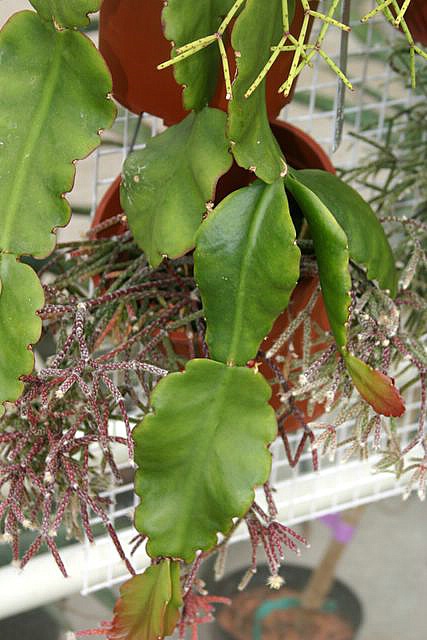Rhipsalis platycarpa Pfeiff., Enum. Diagn. Cact.: 131 . 1837.
Epiphyllum platycarpum Zucc. ex. Pfeiff., Enum. Diagn. Cact.: 131 .1837, pro syn.
Cereus platycarpus Zucc. Plantarum novarum vel minus cognitarum quae in Horto Botanico Herbarioque regio monacensi servantur 3: 736. 1838. TYPE: Pfeiff. & Otto, Abbild. Beschr. Cact. Taf 17, Fig 2. 1838 (neotype, here designated).
Notes; Britton and Rose (1923) present the illustration of Pfeiffer and Otto (1838) as reference to this name. This illustration is here selected as the neotype of R. platycarpa. However, a careful analysis of the neotype and of the original description of this taxon (Zuccarini 1836; Pfeiffer 1837) indicates that R. platycarpa presents flowers with a sub-tetragonal ovary and fruit. These traits are not present in any other species of Rhipsalis, suggesting that this species likely represents another genus of Cactaceae or a specimen with anomalous flowers. -
Rhipsalis platycarpa (Zuccarini) Pfeiffer, Enum. Cact. 131.
(1837)
UNIDENTIFIED by Barthlott and Taylor Bradleya 13
Detail from B&T
Rhipsalis platycarpa (Zuccarini) Pfeiffer (Epiphyllum platycarpum Zuccarini,
‘Cat. Cact.Monac 1836’[quoted from Britton & Rose 1923],
not seen by us and not cited by Zuccarini himself when publishing Cereus
platycarpus Zucc. in Abh. Bayer. Akad. Wiss. Munchen 2:736. 1837, which
clearly postdates R. platycarpa Pfeiffer, Enum. Cact.: 131. 1837). Pfeiffer's
later illustration of a plant under this name (Abbild. Beschr. Cact. 1:
tab. 17. 1840!) depicts a plant with peculiar flowers and cannot be satisfactorily
identified with any extant Rhipsalis known to the present authors. An
herbarium specimen ex Herb. Kummer at Munich (M!) has been determined
as R. platycarpa by Myron Kimnach, but was originally and correctly identified
as R. pachyptera Pfeiffer by an unknown hand in 1838. This is a possible
identity for this poorly typified name, which should not be allowed to
displace R. pachyptera Pfeiffer, if, indeed, it was published earlier.
Info from Britton and Rose
Epiphyllum platycarpum Zuccarini, Cat. Cact. Monac. 1836
Cereus platycarpus Zuccarini, Ahb. Bayer, Akad. Wiss. Munchen
2: 736 1837
Hariota platycarpa Kuntze, Rev. Gen. Pl. 1: 263. 1891.
Branches broad and flat, 1 to 2 dm. long, 3 cm. broad or more, dull green
becoming red
when grown in sunlight, with broad deep crenations;
Flowers borne toward apex of branch, 1 to 3 from an areole, 16 to 18 mm.
long, greenish
yellow or dull white;
Petals 8 mm. long, ovate;
Stamens white;
Stigma-lobes 5, white;
Fruit (doubtless immature) naked, green, somewhat compressed, angled,
truncate.
Type locality: Brazil.
Distribution: Organ Mountains, Brazil.
We have obtained plants of this species from Mr. Lamb at Manchester in 1904 and Dr. Rose found it wild in the Organ Mountains of Brazil in 1915 (No. 21159). It grows well in cultivation but it has never flowered with us.
4. R. platycarpa PFR. 1837
Epiphyllum platycarpum Zucc.
Pa: Brasilia.
R. alata; ramis sinuato-crenatis viridibus (interdum margine rubente),
crenis junioribus luculenter squamatis.
Articuli 4 - 8 poll. longi, 1½ lati, ramis C. Phyllanthi similes,
crenis minus remotis.
Flores prope apicem, 8 lin, longi, sordide albidi. Receptaculum subtetragonum
viride, cristis obtusis rubentibus. Corolla vix aperta; petala ovata,
4 lin. longa. Stamina alba; stylus vix longior, stigmatibus 5 subulatis
patentibus albis. Bacca nuda, virens, compresso-angulosa.
 |
|---|
. platycarpa (copyright KAF, Kew 2006)